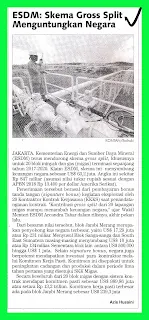PT Pertamina Hulu Energi prepares for the transition period of several termination working areas that have been transferred to the company. One of them is the Southeast Sumatra (SES) working area whose production will be maintained at about 30,000 barrels of equivalent per day.
Development Director of Upper Energy Pertamina (PHE) Afif Saifuddin said that the transition period of Southeast Sumatra (SES) working area is ready ahead of the management transition which is still managed by CNOOC. The company has also prepared the transition plan for the management switch since the end of last year.
"We have prepared various strategies to make the transition smooth and smooth," he said.
According to Afif, SES production is currently in the range of 30,000 barrels oil equivalent per day. The Company will also strive to maintain production within the transition periods.
"We are trying to stay in the range of 30,000 barrels of oil equivalent per day," he said.
He admitted that the management of SES is quite challenging because it belongs to one of the working areas that have aged. The age of existing wells in SES is almost the same as in Offshore North West Java (ONWJ).
"We are also identifying more details about it."
Afif explained that the company will also conduct a new drilling at SES. Only, the drilling scheme will be divided in the next few years.
"We will also be selective in the development of SES. If, there is a field that is not productive will also be closed, too, "he said.
The working area of the SES will end its contract in September 2018. PHE commits the first 3 years for development in the SES working area of US $ 130 million.
SES became one of the 2018 termination work areas that required a switchover from the previous operator, CNOOC. In contrast to some 2018 termination areas, such as Tuban, Ogan Komering, and North Sumatra Offshore already managed by Pertamina previously.
In addition to SES, 2018 terminated oil and gas working areas requiring a transitional period is Sanga-Sanga. Previously, the working area to be terminated in August 2018 was managed by VICO and PT Saka Energi Indonesia. Then, there is also Attaka & East Kalimantan which is used as one working area previously managed by Chevron. Upstream Director of PT Pertamina (Persero) Syamsu Alam said that the termination work transition obtained by the company has been processed immediately.
"The problem is that the transition period of 2018 termination work contract with new contract is very close," he said.
Pertamina received eight termination work areas in 2018. This government-owned company also assigned PHE to four working areas, Tuban, Ogan Komering, SES, and NSO. In addition, Pertamina also assigned another subsidiary of PT Pertamina Hulu Indonesia to manage the work area of Sanga-Sanga, Attaka & East Kalimantan, and the Central Block.
IN INDONESIA
Pertamina Akan Jaga Produksi SES
PT Pertamina Hulu Energi mempersiapkan masa transisi beberapa wilayah kerja terminasi yang sudah dialihkan kepada perseroan. Salah satunya, wilayah kerja Southeast Sumatera (SES) yang produksinya akan dijaga sekitar 30.000 barel ekuivalen per hari. Direktur Pengembangan Pertamina Hulu Energi (PHE) Afif Saifuddin mengatakan bahwa masa transisi wilayah kerja Southeast Sumatera (SES) sudah siap menjelang peralihan pengelolaan yang saat ini masih dikelola oleh CNOOC. Perseroan pun sudah mempersiapkan rencana transisi peralihan pengelolaan itu sejak akhir tahun lalu.
“Kami sudah siapkan berbagai strategi agar masa transisi bisa smooth dan lancar,” ujarnya.
Menurut Afif, produksi SES saat ini berada di kisaran 30.000 barel ekuivalen minyak per hari. Perseroan pun akan berupaya untuk bisa mempertahankan produksi dalam periods peralihan tersebut.
“Kami berupaya untuk bisa terjaga di kisaran 30.000 barel ekuivalen minyak per hari," ujarnya.
Dia mengakui bahwa pengelolaan SES memang cukup menantang karena termasuk salah satu wilayah kerja yang sudah uzur. Umur sumur-sumur yang ada di SES hampir sama dengan di Offshore North West Java (ONWJ).
“Kami pun sedang mengidentifikasi Iebih detail hal tersebut.”
Afif menjelaskan bahwa perseroan pun akan melakukan pengeboran baru di SES. Hanya saja, skema pengeboran akan dibagi dalam beberapa tahun ke depan.
“Kami pun akan selektif juga dalam pengembangan SES. Kalau, ada lapangan yang sudah tidak produktif pun akan Iangsung ditutup juga,” ujarnya.
Wilayah kerja SES akan berakhir kontraknya pada September 2018. PHE memberi komitmen pasti 3 tahun pertama untuk pengembangan di wilayah kerja SES senilai US$ 130 juta.
SES menjadi salah satu wilayah kerja terminasi 2018 yang membutuhkan masa peralihan dari operator sebelumnya yakni, CNOOC. Berbeda dengan beberapa wilayah kerja terminasi 2018, seperti Tuban, Ogan Komering, dan North Sumatera Offshore yang memang sudah dikelola oleh Pertamina sebelumnya.
Selain SES, wilayah kerja migas terminasi 2018 yang membutuhkan periode peralihan adalah Sanga-Sanga. Sebelumnya, wilayah kerja yang akan terminasi pada Agustus 2018 itu dikelola oleh VICO dan PT Saka Energi Indonesia. Lalu, ada juga Attaka & East Kalimantan yang dijadikan satu wilayah kerja yang sebelumnya dikelola oleh Chevron. Direktur Hulu PT Pertamina (Persero) Syamsu Alam mengatakan bahwa transisi wilayah kerja terminasi yang didapatkan perseroan sudah langsung diproses secepatnya.
“Soalnya, masa peralihan habis kontrak wilayah kerja terminasi 2018 itu dengan kontrak baru sangat berdekatan,” ujarnya.
Pertamina mendapatkan delapan wilayah kerja terminasi 2018 tersebut. Perusahaan milik pemerintah ini pun menugaskan PHE pada empat wilayah kerja yakni, Tuban, Ogan Komering, SES, dan NSO. Selain itu, Pertamina juga menugaskan anak usaha lainnya yakni PT Pertamina Hulu Indonesia untuk mengelola wilayah kerja Sanga-Sanga, Attaka & East Kalimantan, dan Blok Tengah.
Bisnis Indonesia, Page-22, Friday, June 22, 2018












